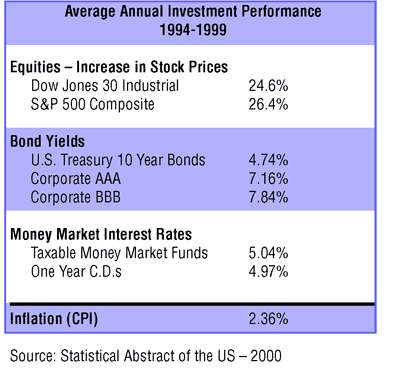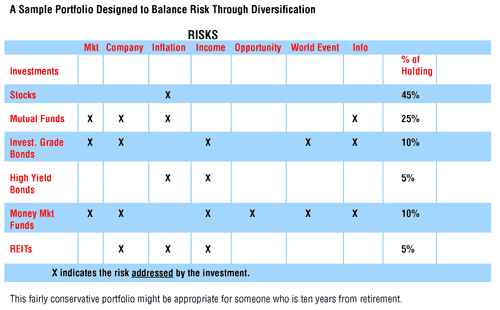
HOT TOPICS LIST
- Strategies
- Stocks
- Buy
- Investing
- Brokers
- Psychology
- Interviews
- Accumulate
- Sell
- Hold
- Spotlight
- Websites
- Candlestick Corner
- Gold & Metals
- Options Trading
LIST OF TOPICS
MONEY MANAGEMENT
Reduce Your Investment Risks
04/16/02 03:51:02 PM PSTby Michael B. Patterson
Were you caught in the Internet bubble or the collapse of Enron?
| Glamour stocks, accounting scandals, global political crises -- all of these make you realize the importance of one of the basic lessons in investing: diversification. Most of you are familiar with the concept of diversifying a portfolio in order to spread investment risks. But good diversification requires more than just randomly acquiring a variety of different securities. You should be able to recognize the types of risk that threaten various elements of a portfolio, and assess each risk in light of an investment plan and your personal risk tolerance. Only then can you build a sound, well-balanced portfolio.
INVESTMENT RISKSThere are different types of risks when it comes to investing. Some of the more common ones are:
Private investors may face many other risks, depending upon the type of investment. Bondholders, for example, face the risk of bond default and the risk of the bond being called. This leads to reinvestment or interest rate risk. When a bond is redeemed or an investment sold, the reinvestment options may not be as attractive as the previous investment. Overseas investments may also carry a currency risk resulting from exchange-rate fluctuations.
ASSESSING YOUR RISKSThe significance of each risk varies depending on your investment situation. Company and market risks are clearly major risks for stock investment. Income and timing can be of great concern to someone nearing retirement or considering a major expenditure such as buying a house. Opportunity risk is important to someone who foresees a rapidly changing market or a new potential investment. Over time as your portfolio and personal situation evolve, the assessment of each risk should change.
YOUR INVESTMENT CHOICESSome investment instruments you may want to consider are:
This list is far from comprehensive. It does, however, contain some common investment vehicles. The display in Figure 1 gives you an idea of how various types of investments performed during a bull market phase between 1994 and 1999.
Figure 1: Average annual investment performance 199499. POINTS TO CONSIDERHere are a few more things to keep in mind:
Diversification is not an optimization technique. By dispersing your money throughout a carefully selected array of investments, you reduce the risk of experiencing a large loss from a single investment or type of investment. Optimization, on the other hand, would require that you put all your eggs in one investment basket. You would then reap the reward if that one investment surpassed the other alternatives. Unfortunately, the opposite can also happen, causing you to experience a significant loss when your investment goes down. Clearly, spreading risk through well-conceived diversification is the best way to protect your investments while realizing long-term gains. You should also note some of the traps you may encounter once you have diversified. When one group of stocks go up while other stocks languish or go down, the temptation is to sell the losers and increase investment in the current leaders. But by chasing the market in this way, your diversification is reduced, leaving you ill-prepared when the market changes direction and a different group of investments takes the lead.
How many individual stocks should you own? The rule of thumb suggested by Benjamin Graham in 1949 was that 10 to 30 stocks would provide sufficient diversification, and that 15 was a reasonable number to hold. This advice was confirmed in later studies and the concept prevailed into the 1990s. In more recent years, however, the nature of stock movement has changed. Individual stocks have become much more volatile. This is partly because many companies have focused their businesses rather than become conglomerates, and thus, they have no internal diversification. Another explanation is the trend toward listing relatively new companies that have not yet developed an extensive market for their products. In addition, there is the increased role of money managers who tend to move quickly when a company makes an announcement. The managers' combined actions can result in abrupt price changes. Recent research suggests that an investor must hold 50 stocks to obtain the diversification once provided by 15 stocks. If you are going to adhere to this strategy, you should hold as many stocks as you can adequately track, analyze, and manage. This will probably be far fewer than 50 stocks, but certainly more than 15. Of course, another option is to invest in mutual funds, since they typically own a large number of securities.
Be careful about overlap. Mutual funds, particularly those in the same fund company, may have similar holdings. Diversifying into several funds won't achieve your objective if all the funds are heavily weighted with the same stocks. In addition, be careful your mutual funds aren't weighted with the same companies contained in your stock portfolio. To check for overlap between mutual funds, read their prospectuses or semiannual reports. Help can also be found at www.morningstar.com, www.troweprice.com, or www.maxfunds.com.
PUTTING IT TOGETHERThe first step is to have a long-range investment plan. This plan should include your investment objectives, investment time frames, and your tolerance for risk. Decide how significant each investment risk is when reflected against your specific goals. The end result of your analysis should be the development of a well-balanced and diversified portfolio that is compatible with your assessment of all the individual risks. Further, you can obtain a measure of the individual risk associated with each of your stocks or bonds by going to www.riskgrades.com. An example of a diversified portfolio can be seen in Figure 2.
Figure 2: A sample portfolio. The risks are balanced through diversification.
But having a well-diversified portfolio isn't enough. You also need to monitor each investment's performance. Periodically, perhaps once a year, rebalance your portfolio to maintain an appropriate ratio of equities, bonds, cash, and other investments. As you do this, trim back your successful investments to prevent them from assuming too much weight in your portfolio. Keep in mind, though, that shuffling investments around can expose you to capital gains. Above all, as you develop a diversified portfolio, stay away from investments you don't fully understand, as they can become the real source of risk.
Michael B. Patterson is a former management professor, dean, and college vice president. He has written a variety of articles on business and management.
SUGGESTED READINGHutson, Jason [2001]. "Risk: How Much Is Too Much?" Working Money: November/December.Gopalakrishnan, Jayanthi [2001]. "Riskgrades.com," review, Working Money: May. Sidewitz, R.M. [2001]. "Can You Stay In the Game?" Working Money: July.
Current and past articles fromWorking Money, The Investors' Magazine, can be found at Working-Money.com.
|
PRINT THIS ARTICLE

|

Request Information From Our Sponsors
- StockCharts.com, Inc.
- Candle Patterns
- Candlestick Charting Explained
- Intermarket Technical Analysis
- John Murphy on Chart Analysis
- John Murphy's Chart Pattern Recognition
- John Murphy's Market Message
- MurphyExplainsMarketAnalysis-Intermarket Analysis
- MurphyExplainsMarketAnalysis-Visual Analysis
- StockCharts.com
- Technical Analysis of the Financial Markets
- The Visual Investor
- VectorVest, Inc.
- Executive Premier Workshop
- One-Day Options Course
- OptionsPro
- Retirement Income Workshop
- Sure-Fire Trading Systems (VectorVest, Inc.)
- Trading as a Business Workshop
- VectorVest 7 EOD
- VectorVest 7 RealTime/IntraDay
- VectorVest AutoTester
- VectorVest Educational Services
- VectorVest OnLine
- VectorVest Options Analyzer
- VectorVest ProGraphics v6.0
- VectorVest ProTrader 7
- VectorVest RealTime Derby Tool
- VectorVest Simulator
- VectorVest Variator
- VectorVest Watchdog


